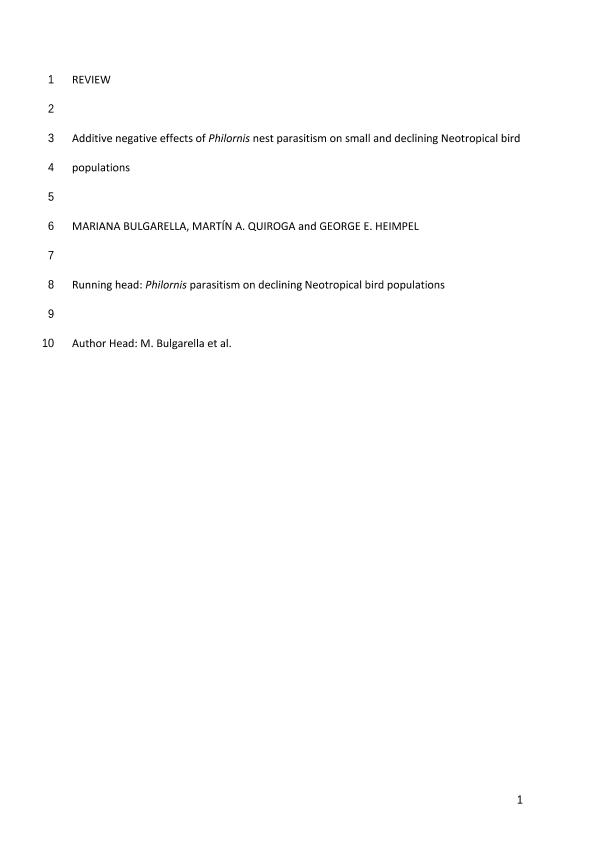Mostrar el registro sencillo del ítem
dc.contributor.author
Bulgarella, Mariana

dc.contributor.author
Quiroga, Martin Anibal

dc.contributor.author
Heimpel, George E.
dc.date.available
2019-10-18T21:29:05Z
dc.date.issued
2018-09
dc.identifier.citation
Bulgarella, Mariana; Quiroga, Martin Anibal; Heimpel, George E.; Additive negative effects of Philornis nest parasitism on small and declining Neotropical bird populations; Elsevier; Biological Conservation; 9-2018
dc.identifier.issn
0006-3207
dc.identifier.uri
http://hdl.handle.net/11336/86509
dc.description.abstract
The declining-population paradigm holds that small populations are particularly vulnerable to anthropogenic influences such as habitat destruction, pollution and species introductions. While the effects of particular stressors, such as parasitism, may be unimportant in a large, healthy population, they can be serious and even devastating in situations characterized by a restricted geographic range, or by fragmented or reduced population sizes. We apply this idea to nest parasitism of threatened Neotropical bird species that exist in small populations, focusing on dipteran nest parasites in the genus Philornis. We review the literature on Philornis parasitism exerting negative pressure on bird populations that have become small and isolated due to human actions and present a new case of Philornis parasitism of a threatened hummingbird species. Our aim is to raise awareness about the exacerbating effect that nest parasites can have on small and declining bird populations; especially when biological information is scarce. The five reviewed cases involve two species of Darwin?s Finches in the Galápagos Islands attacked by the invasive P. downsi, two species of hawks on islands in the Caribbean attacked by the native P. pici and P. obscura, and the Yellow Cardinal (Gubernatrix cristata) in southern South America attacked by an unknown Philornis species. We also present new documentation of parasitism of a threatened hummingbird species in mainland Ecuador by an unidentified Philornis species. We recommend more field studies to determine the presence of nest parasites in bird populations worldwide to improve understanding how nest parasites affect bird fitness and population viability and to allow time to act in advance if needed. Parasitism by Philornis may represent a severe mortality factor in most already threatened bird species, putting them at greater risk of extinction. Therefore, parasitism management should be included in all threatened species recovery plans.
dc.format
application/pdf
dc.language.iso
eng
dc.publisher
Elsevier

dc.rights
info:eu-repo/semantics/openAccess
dc.rights.uri
https://creativecommons.org/licenses/by-nc-sa/2.5/ar/
dc.subject
avian nest parasites
dc.subject
host-parasite interactions
dc.subject
neotropics
dc.subject
Philornis
dc.subject.classification
Zoología, Ornitología, Entomología, Etología

dc.subject.classification
Ciencias Biológicas

dc.subject.classification
CIENCIAS NATURALES Y EXACTAS

dc.title
Additive negative effects of Philornis nest parasitism on small and declining Neotropical bird populations
dc.type
info:eu-repo/semantics/article
dc.type
info:ar-repo/semantics/artículo
dc.type
info:eu-repo/semantics/publishedVersion
dc.date.updated
2019-10-18T18:36:52Z
dc.journal.pais
Países Bajos

dc.journal.ciudad
Amsterdam
dc.description.fil
Fil: Bulgarella, Mariana. Victoria University Of Wellington;
dc.description.fil
Fil: Quiroga, Martin Anibal. Consejo Nacional de Investigaciones Científicas y Técnicas. Centro Científico Tecnológico Conicet - Santa Fe. Instituto de Ciencias Veterinarias del Litoral. Universidad Nacional del Litoral. Facultad de Ciencias Veterinarias. Instituto de Ciencias Veterinarias del Litoral; Argentina
dc.description.fil
Fil: Heimpel, George E.. University of Minnesota; Estados Unidos
dc.journal.title
Biological Conservation

Archivos asociados
